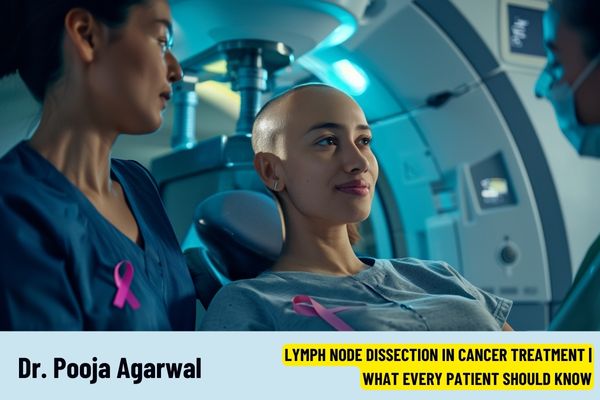Lymph Node Dissection in Cancer Treatment | What Every Patient Should Know
Expert Insights from Dr. Pooja Agarwal
When you’re facing cancer, every step of diagnosis and treatment matters. One such step is lymph node dissection, a surgical procedure that plays a crucial role in understanding the spread of cancer. To help patients make informed decisions, Dr. Pooja Agarwal, an experienced breast cancer surgeon, shares her insights into this vital part of cancer care.
🔍 What Is Lymph Node Dissection?
Lymph nodes are small, bean-shaped structures that are part of the body’s immune system. Cancer often spreads through the lymphatic system, making these nodes important markers in cancer staging and treatment planning.
Lymph node dissection (also called lymphadenectomy) is the surgical removal of one or more lymph nodes to determine whether cancer has spread beyond its original site.
🩺 Why Is It Done?
According to Dr. Pooja Agarwal, “Lymph node dissection helps us not only determine the stage of cancer but also plan the next steps in treatment. It’s especially important in breast cancer, gynecological cancers, and melanoma.”
Key Purposes:
- Cancer Staging: Understand how far cancer has spread.
- Treatment Planning: Helps decide if chemotherapy, radiation, or further surgery is needed.
- Prognostic Value: Provides important information about patient outcomes.
- Disease Control: In some cases, removing affected lymph nodes prevents further spread.
🔎 Types of Lymph Node Dissection
✅ Sentinel Lymph Node Biopsy (SLNB)
- The first lymph node(s) to which cancer is likely to spread.
- Less invasive and often used in early-stage breast cancer.
- If no cancer is found, no further lymph nodes are removed.
✅ Axillary or Regional Lymph Node Dissection
- Removal of multiple lymph nodes from a specific area (e.g., underarm, neck, groin).
- Performed when cancer is confirmed in sentinel nodes or if there’s a high risk of spread.
⚙️ How the Procedure Works
The surgery is typically done under general anesthesia. The duration and extent of the procedure depend on the location and type of cancer. In many cases, lymph node dissection is done along with tumor removal or mastectomy.
Dr. Pooja Agarwal emphasizes, “We prioritize minimally invasive techniques whenever possible to ensure better recovery and fewer complications.”
🩹 Recovery and Possible Side Effects
Most patients recover within a couple of weeks. However, side effects can occur and may include:
- Lymphedema (swelling) in the arm or leg near the surgical site
- Pain or numbness due to nerve irritation
- Limited range of motion, especially after axillary dissection
- Infection or fluid buildup (seroma)
Dr. Agarwal’s Tip: “Early physiotherapy and arm exercises are key to reducing the risk of lymphedema and stiffness after surgery.”
💬 Questions to Ask Your Surgeon
- Do I need sentinel node biopsy or full dissection?
- How many lymph nodes will be removed?
- What’s the risk of lymphedema in my case?
- What should I expect in terms of recovery?
- Will this impact my chemotherapy or radiation schedule?
🧠 Final Thoughts from Dr. Pooja Agarwal
“Lymph node dissection is a powerful tool in our fight against cancer. While it may sound daunting, it’s often an essential part of staging and managing the disease effectively. Patients who understand why it’s done and what to expect often feel more confident and empowered throughout their treatment journey.”

